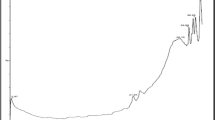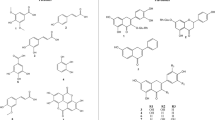Abstract
Medicinal plants play a vital role in the healthcare of many people in Africa and other developing countries. Of these, Hura crepitans L. is used in some parts of Nigeria and Ghana in the management of liver diseases. This study evaluated the hepatoprotective effects of the aqueous (AE) and ethanolic extracts (EE) of H. crepitans stem bark in CCl4-induced liver injury in Sprague-Dawley rats. Liver injury was induced by single oral administration of 1 mL/kg b.wt CCl4 (1:1 v/v olive oil). The effect of AE and EE was assessed at 250 mg/kg p.o. Serum and liver biochemical markers were measured, and liver was assessed for oxidative stress, morphological changes, and expression of some pro-inflammatory cytokines. EE, AE, and silymarin displayed significant hepatoprotective activities by ameliorating the activities of transaminase (ALT and AST) and alkaline phosphatase (ALP) and decreased the levels of total bilirubin (TBIL) following increases induced by CCl4. It further enhanced the antioxidant defence enzymes and reduced glutathione (GSH) activities, while preventing lipid peroxidation. Extract further attenuated liver damage and inflammation by offering some inhibitory effect on nuclear factor kappa B (NF-κB) expression, leading to downregulation of cyclooxygenase-2 (COX-2), interleukin-17 (IL-17), and interleukin-23 (IL-23). This study demonstrated AE and EE to be hepatoprotective, and the mechanism of hepatoprotection was through the enhancement of the antioxidant defence system with resultant mitigation of lipid peroxidation. They also showed hepatoprotective effect through the inhibition of NF-κB, thus leading to the reduction in inflammation.






Similar content being viewed by others
References
Adedara IA, Owumi SE, Uwaifo AO, Farombi EO (2010) Aflatoxin B1 and ethanol co-exposure induces hepatic oxidative damage in mice. Toxicol Ind Health 26(10):717–724
Adewuyi A, Otuechere CA, Adebayo OL, Anazodo C, Pereira FV (2018) Renal toxicological evaluations of sulphonated nanocellulose from Khaya sengalensis seed in Wistar rats. Chem Biol Interact 284:56–68
Apel K, Hirt H (2004) Reactive oxygen species: metabolism, oxidative stress, and signal transduction. Annu Rev Plant Biol 55:373–399
Bataller R, Brenner DA (2005) Liver fibrosis. J Clin Investig 115(2):209–218. https://doi.org/10.1172/JCI24282
Bhawna S, Kumar SU (2009) Hepatoprotective activity of some indigenous plants. Int J Pharm Tech Res 4:1330–1334
Bose KS, Agrawal BK (2007) Effect of lycopene from cooked tomatoes on serum antioxidant enzymes, lipid peroxidation rate and lipid profile in coronary heart disease. Singap Med J 48:415–420
Cakici O, Akat E (2013) Effects of oral exposure to diazinon on mice liver and kidney tissues: biometric analyses of histopathologic changes. Anal Quant Cytopathol Histpathol 35:7–16
Campo GM, Avenoso A, Campo S, Nastasi G, Traina P, D’ascola A et al (2008) The antioxidant activity of chondroitin-4-sulphate, in carbon tetrachloride induced acute hepatitis in mice, involves NF-KB and caspase activation. Br J Pharmacol 155(6):945–956
European Association for the Study of the Liver (2018) EASL Clinical practice guidelines: management of hepatocellular carcinoma. J Hepatol 69:182–236
Feng Y, Wang N, Ye X, Li H, Feng Y, Cheung F, Nagamatsu T (2011) Hepatoprotective effect and its possible mechanism of Coptidis rhizoma aqueous extract on carbon tetrachloride-induced chronic liver hepatotoxicity in rats. J Ethnopharmacol 138:683–690
Floreani A, De Martin S, Secchi MF, Cazzagon N (2019) Extrahepatic autoimmunity in autoimmune liver disease. Eur J Intern Med 59:1–7
Igwenyi IO, Agu EA, Awoke JN, Nzubechukwu E, Famurewa AC, Obasi NA et al (2017) Antidiabetic and hepatoprotective effect of Hura crepitans seed extract in alloxan-induced diabetic albino rats. Int J Biol Pharm Allied Sci 6(9):1771–1780
Jarikre TA, Emikpe BO (2017) First report of immunohistochemical detection of Peste des petit ruminants, parainfluenza 3 and respiratory syncytial viral antigens in lungs of Nigerian goats. J Immunoass Immunochem 38:555–568. https://doi.org/10.1080/15321819.2017.1349669
Kotoh K, Kato M, Kohjima M, Tanaka M, Miyazaki M, Nakamura K, Enjoji M, Nakamuta M, Takayanagi R (2011) Lactate dehydrogenase production in hepatocytes is increased at an early stage of acute liver failure. Exp Ther Med 2(2):195–199. https://doi.org/10.3892/etm.2011.197
Larbie C, Torkornoo D, Nyanor E, Asibey O (2016) Evaluation of the hepatoprotective potential of hydroethanolic extract of Ficus pumila L. on CCl4 induced liver damage in rats. Glob J Res Med Plants Indigenous Med 5(7):217–225
Li AN, Li S, Zhang YJ, Xu XR, Chen YM, Li HB (2014) Resources and biological activities of natural polyphenols. Nutrients 6:6020–6047
Madrigal-Santillán E, Madrigal-Bujaidar E, Álvarez-González S-MMT, Gutiérrez-Salinas J et al (2014) Natural products with hepatoprotective effects. World J Gastroenterol 20(40):14787–14804
Marcellin P, Kutala BK (2018) Liver diseases: a major, neglected global public health problem requiring urgent actions and large-scale screening. Liver Int 38:2–6
Medina J, Moreno-Otero R (2005) Pathophysiological basis for antioxidant therapy in chronic liver disease. Drugs 65:2445–2461
Mrdjen I, Morse MA, Ruch RJ, Knobloch TJ, Choudhary S, Weghorst CM, Lee J (2018) Impact of microcystin-LR on liver function varies by dose and sex in mice. Toxins 10:435
National Research Council (2011) Guide for care and use of laboratory animal, 8th edn. National Academic Press, Washington, pp 43–45
Nyarko RA, Larbie C, Anning AK, Baidoo PK, Emikpe BO, Oyagbemi AA, Jarikee JA (2019) Griffonia simplicifolia (DC.) Baill. attenuates gentamicin and cisplatin-induced nephrotoxicity in rats. Comp Clin Pathol 28:1–12. https://doi.org/10.1007/s00580-019-02934-x
Oloyede GK, Adaramoye OA, Olatinwo MB (2016) Chemical constituents of sandbox tree (Hura crepitans Linn.) and anti hepatoxic activity of leaves and stem bark extracts. West Indian Med J. https://doi.org/10.7727/wimj.2015.247
Omabe M, Omabe K, Igwe D, John O, Uchenna S, Elom S (2018) Xenobiotics-induced liver damage is biochemically abrogated by treatment with lipophilic extracts of Moringa oleifera in vivo. Health 10:313–325
Orisakwe OE, Njan AA, Afonne OJ, Akumka DD, Orish VN, Udemezue OO (2004) Investigation into the nephrotoxicity of Nigerian bonny light crude oil in albino rats. International. J Environ Resid Publ Health 1:106–110
Owojuyigbe OS, Firempong CK, Komlaga G, Larbie C, Emikpe BO (2020) Phytochemical, antioxidant and safety evaluation of Hura crepitans (L.) stem bark hydroethanolic extract in animal. Eur J Med Plants 31(8):1–16. https://doi.org/10.9734/ejmp/2020/v31i830255
Palma HE, Wolkmer P, Gallio M, Corrêa MM, Schmatz R, Thomé GR et al (2014) Oxidative stress parameters in blood, liver, and kidney of diabetic rats treated with curcumin and/or insulin. Mol Cell Biochem 386:199–210. https://doi.org/10.1007/s11010-013-1858-5
Park MH, Hong JT (2016) Roles of NF-κB in cancer and inflammatory diseases and their therapeutic approaches. Cells 5(2):E15. https://doi.org/10.3390/cells5020015
Parker W, Hornik CD, Bilbo S, Holzknecht ZE, Gentry GL et al (2017) The role of oxidative stress, inflammation and acetaminophen exposure from birth to early childhood in the induction of autism. J Int Med Res 45(2):407–438
Rai MK (1994) Herbal medicines in India: retrospect and prospect. Fitoterapia 65(6):483–491
Ramsay RG, Ciznadija D, Vanevski M, Mantamadiotis T (2003) Transcriptional regulation of cyclo-oxygenase expression: three pillars of control. Int J Immunopathol Pharmacol 16(2):59–67
Reyes-Gordillo K, Shah R, Muriel P (2017) Oxidative stress and inflammation in hepatic diseases: current and future therapy. Oxidative Med Cell Longev 3140673:1–2. https://doi.org/10.1155/2017/3140673
Schuppan D, Jia JD, Brinkhaus B, Hahn EG (1999) Herbal products for liver diseases: a therapeutic challenge for the new millennium. Hepatology 30(4):1099–1104
Shah MD, Iqbal M (2010) Diazinon-induced oxidative stress and renal dysfunction in rats. Food Chem Toxicol 48:3345–3353. https://doi.org/10.1016/j.fct.2010.09.003
Singal AK, Jampana SC, Weinman SA (2011) Antioxidants as therapeutic agents for liver disease. Liver Int 31:1432–1448. https://doi.org/10.1111/j.1478-3231.2011.02604.x
Spearman CW, Sonderup MW (2015) Health disparities in liver disease in sub-Saharan Africa. Liver Int 35(9):2063–2071
Srivastava A, Shivanandappa T (2010) Hepatoprotective effect of the root extract of Decalepis hamiltonii against carbon tetrachloride-induced oxidative stress in rats. Food Chem 118:411–417
Umezawa K, Kawahata N, Mizoguchi F, Naoki K, Yoko YN, Nobuyuki M, Hitoshi K (2018) Interleukin-23 as a therapeutic target for inflammatory myopathy. Sci Rep 8:5498. https://doi.org/10.1038/s41598-018-23539-4
Vargas-Mendoza N, Madrigal-Santillán E, Morales-González A, Esquivel-Soto J, Esquivel-Chirino C, García-Luna Y González-Rubio M, Gayosso-de-Lucio JA, Morales-González JA (2014) Hepatoprotective effect of silymarin. World J Hepatol 6(3):144–149. https://doi.org/10.4254/wjh.v6.i3.144
Zou J, Qi F, Ye L, Yao S (2016) Protective role of grape seed proanthocyanidins against CCl4 induced acute liver injury in mice. Med Sci Monit 22:880–888
Funding
The current study was supported by funding through TETFund, Nigeria, awarded to Oluwole S. Owojuyigbe.
Author information
Authors and Affiliations
Contributions
Conceptualisation: Oluwole S. Owojuyigbe, Christopher Larbie, Caleb K. Firempong, Gustav Komlaga; methodology: Oluwole S. Owojuyigbe, Christopher Larbie, Benjamin O. Emikpe, and Chiagoziem A. Otuechere; formal analysis and investigation: Oluwole S. Owojuyigbe, Christopher Larbie, Benjamin O. Emikpe, and Chiagoziem A. Otuechere; writing—original draft preparation: Oluwole S. Owojuyigbe; writing—review and editing: Oluwole S. Owojuyigbe, Christopher Larbie, Caleb K. Firempong, Gustav Komlaga, Benjamin O. Emikpe, and Chiagoziem A. Otuechere; funding acquisition: Oluwole S. Owojuyigbe; resources: Oluwole S. Owojuyigbe, Christopher Larbie, Benjamin O. Emikpe, and Chiagoziem A. Otuechere; supervision: Christopher Larbie, Caleb K. Firempong, Gustav Komlaga
Corresponding author
Ethics declarations
Conflict of interest
The authors declare that they have no conflict of interest.
Ethics approval
All animals were humanely handled during the experiment. The study protocol was reviewed and approved by a veterinarian on the research team.
Additional information
Publisher’s note
Springer Nature remains neutral with regard to jurisdictional claims in published maps and institutional affiliations.
Rights and permissions
About this article
Cite this article
Owojuyigbe, O.S., Larbie, C., Firempong, C.K. et al. Extracts of Hura crepitans L. stem bark attenuate liver injury and inflammation induced by CCl4 in rats. Comp Clin Pathol 29, 1199–1208 (2020). https://doi.org/10.1007/s00580-020-03172-2
Received:
Accepted:
Published:
Issue Date:
DOI: https://doi.org/10.1007/s00580-020-03172-2




